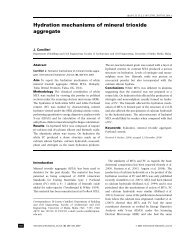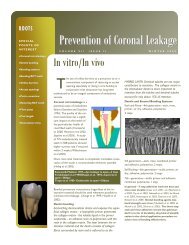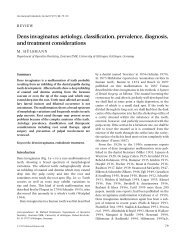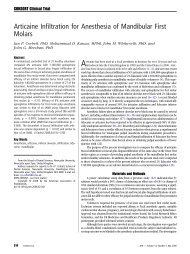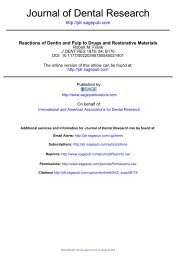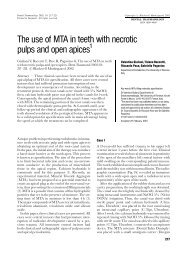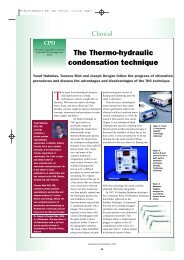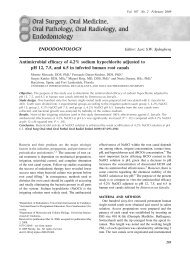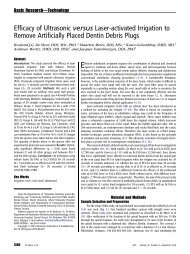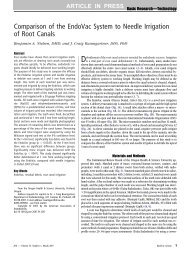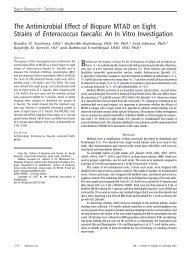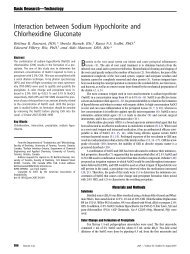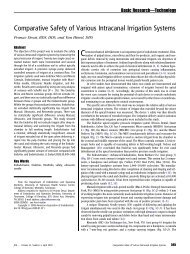A Century Of Endodontics: From Philadelphia To Boston - The ...
A Century Of Endodontics: From Philadelphia To Boston - The ...
A Century Of Endodontics: From Philadelphia To Boston - The ...
Create successful ePaper yourself
Turn your PDF publications into a flip-book with our unique Google optimized e-Paper software.
Photos courtesy of the University of Pennsylvania Archives<br />
Dr. Louis Grossman was instrumental in<br />
establishing the specialty of endodontics.<br />
Louis Irwin Grossman was born in a small Ukrainian<br />
village near Odessa in 1901. A few years<br />
later, his family immigrated to <strong>Philadelphia</strong>. As a<br />
prodigious student, he graduated from the South <strong>Philadelphia</strong><br />
High School in 1919 1 and recalled working from<br />
6 to 10 p.m. during those years at the local newspaper.<br />
It was there that he learned the love of the written word<br />
and even considered a future as a journalist. However,<br />
he had been accepted at the University of Pennsylvania<br />
School of Dentistry (now known as the School of Dental<br />
Medicine) for the class of 1923.<br />
A <strong>Century</strong> of<br />
<strong>Endodontics</strong>:<br />
<strong>From</strong> <strong>Philadelphia</strong><br />
to <strong>Boston</strong><br />
CHARLES B. MILLSTEIN, DMD, MPH<br />
Dr. Millstein is the historian of the<br />
Massachusetts Dental Society, as well as an<br />
endodontist with a practice in Cambridge.<br />
Before the school year began, he visited the Thomas W.<br />
Evans Museum and Dental Institute on 4001 Spruce Street in<br />
<strong>Philadelphia</strong>. By chance, he noticed the well-known professor of<br />
Materia Medica and <strong>The</strong>rapeutics, Dr. Hermann Prinz, whose<br />
accent and linguistic proficiency caught Grossman’s ear. Dr. Prinz<br />
would become a father figure to Dr. Grossman, urging him after<br />
graduation in 1923 to undertake further study at the University<br />
of Rostock Dental School, which was situated in a small town on<br />
the Baltic Sea, where German was the language of instruction.<br />
Dr. Grossman earned his DMD from Rostock in 1928. 2 His<br />
thesis surveyed the various techniques of endodontic practice<br />
taught at the dental schools in the United States. 3<br />
Penn’s Dr. Joseph T. L. Appleton also took an interest<br />
in this ambitious young graduate, guiding and encouraging<br />
Dr. Grossman in his research efforts in bacteriology. Through<br />
Drs. Prinz and Appleton, Dr. Grossman met other prominent<br />
men in the dental profession. Now he would add his journalistic<br />
skills to this newfound wealth of knowledge and become a<br />
scientific exponent and writer for the fledgling specialty known<br />
as endodontia. 2<br />
Over the next 40 years, Dr. Grossman meticulously researched<br />
all phases of root canal therapy. With his knowledge of<br />
bacteriology, he was able to successfully help discredit the “focal<br />
infection theory” set in motion in 1910 by British physician William<br />
Hunter. By 1950, Dr. Grossman and others eventually put<br />
an end to the needless extraction of millions of teeth.<br />
By the 1950s, with funding from the National<br />
Institute of Dental Research, multidisciplinary<br />
investigations into the basic<br />
sciences of bacteriology, pathology, pharmacology,<br />
and immunology contributed<br />
to a better understanding of the infected<br />
pulp and periapical pathology. Clinical<br />
observation based on considerable experience<br />
also led to a fuller understanding of<br />
problems related to failure of previously<br />
successful cases. <strong>Endodontics</strong> became the<br />
accepted treatment and the preservation<br />
of the dentition a priority for the dental<br />
profession. 4<br />
Dr. Grossman published voluminously<br />
and lectured endlessly on the<br />
topic both here and abroad, and in 1940<br />
he wrote the first of 11 editions of Root<br />
Canal <strong>The</strong>rapy (later retitled Endodontic<br />
Practice), published by Lea & Febiger<br />
of <strong>Philadelphia</strong>. <strong>The</strong>se seminal contributions<br />
occurred within Penn’s Department<br />
of Oral Medicine, chaired by Lester Burket,<br />
DDS, who would go on to become<br />
dean of the Penn School of Dental Medicine.<br />
Beginning in 1953, Dr. Grossman<br />
oversaw a series of six International Conferences<br />
on <strong>Endodontics</strong> given every five<br />
years at Penn. <strong>The</strong> University Press published<br />
these as bound transactions of the<br />
events. 5 In 1964, Dr. Grossman initiated<br />
a postgraduate department of endodontics<br />
at Penn. Upon his mandatory retirement<br />
in 1968, the university established<br />
its first Department of <strong>Endodontics</strong> and<br />
the Louis I. Grossman Professorship in<br />
<strong>Endodontics</strong>. Former associate Seymour<br />
Oliet, DDS, occupied the first chair. 6<br />
Penn later honored Dr. Grossman with a<br />
Doctor of Science degree in 1978.<br />
<strong>The</strong> Future of Root Canal <strong>The</strong>rapy<br />
Realizing the need for a group of likeminded<br />
clinicians to set the stage for the<br />
future of root canal therapy, Dr. Grossman<br />
organized the <strong>Philadelphia</strong> Study<br />
Club in 1939. Two of the earliest members<br />
included his previous dental students,<br />
Drs. Israel Boris Bender and Samuel<br />
Seltzer. 7 This success was followed with a<br />
call for a national organization and was<br />
encouraged by both Dr. William J. Gies,<br />
founder of the International Association<br />
of Dental Research, and Dr. L. Pierce<br />
Anthony, editor of the Journal of the<br />
American Dental Association (JADA).<br />
When notified that W. Clyde Davis,<br />
DDS, a dentist from Lincoln, Nebraska,<br />
was also interested in a similar organization,<br />
Dr. Grossman invited him to serve on<br />
an organizing committee of the American<br />
Root <strong>The</strong>rapy Association. <strong>The</strong> gathering<br />
would coincide with the Chicago Dental<br />
Society meeting, and an announcement<br />
would be placed in JADA. Nineteen dentists<br />
from various sections of the country<br />
met at the Palmer House Hotel in Chicago<br />
on January 23, 1943, for the purpose of<br />
organizing a society for the study of root<br />
canal therapy. After a spirited discussion,<br />
they voted to name it the American Association<br />
of Endodontists (AAE). 8<br />
Twenty-one years later, endodontics<br />
was accepted by the American Dental<br />
Association as a recognized specialty.<br />
<strong>The</strong> American Board of <strong>Endodontics</strong> was<br />
incorporated in 1956, was recognized<br />
and approved by the Council on Dental<br />
Education in 1957, and gave its first examinations<br />
in 1965. 9 <strong>The</strong> board became<br />
a reality due to the work of Dr. George<br />
Stewart, Dr. Grossman’s former associate<br />
at Penn, and Dr. Jacob Freedland of<br />
North Carolina. 10<br />
As the pioneering moment in endodontic<br />
history began to wane with its<br />
acceptance as a specialty, the founders<br />
began to prepare for the next generation<br />
of postdoctoral students, educators, and<br />
researchers. <strong>The</strong>se early leaders convened<br />
for a Workshop on Advanced Education<br />
in <strong>Endodontics</strong> given at the Forsyth Dental<br />
Center in <strong>Boston</strong> in October 1966.<br />
Two of the organizers were Drs. Louis<br />
Grossman and Ralph Sommer.<br />
As president-elect of the American<br />
Dental Association, Dr. F. Darl Ostrander<br />
of the University of Michigan was<br />
instrumental in the passage of the specialty<br />
status for endodontics. Along with<br />
Dr. Sommer, he was a seminal figure in<br />
endodontic education. In his paper, “<strong>The</strong><br />
Past, Present, and Future of the Practice<br />
of <strong>Endodontics</strong>,” Dr. Ostrander noted:<br />
“It is abundantly clear that the future of<br />
endodontics depends on expanded and<br />
greatly improved teaching at all levels<br />
of dental education and research in endodontics<br />
and related areas. If these goals<br />
can be accomplished, it seems logical to<br />
expect that the techniques required for<br />
therapy will become simplified. This condition<br />
should allow the general practitioner<br />
to treat successfully a larger number of<br />
endodontic cases and should make possible<br />
greatly expanded care by the endodontic<br />
specialist.” 11<br />
<strong>The</strong> <strong>Boston</strong> Legacy<br />
Back in 1878, the Pennsylvania College<br />
of Dental Surgery, a proprietary school,<br />
morphed into the Dental Department<br />
at the University of Pennsylvania. 12 Seventy<br />
years later, a hospital-based dental<br />
school dedicated solely to graduate den-<br />
<strong>The</strong> Thomas W. Evans Museum and Dental Institute was completed in 1915 and would become<br />
home to the University of Pennsylvania School of Dentistry.<br />
22 Journal of the Massachusetts Dental Society Vol. 59/No. 2 Summer 2010 23<br />
Photo courtesy of the University of Pennsylvania Archives
Photo courtesy of the University of Pennsylvania Archives<br />
Dr. David Walter Cohen<br />
tistry was in the process of crystallizing in<br />
<strong>Boston</strong>. <strong>The</strong> venture would be grounded<br />
on a sound biological rationale with close<br />
cooperation between dental medicine and<br />
total health. It was led by Henry M. Goldman,<br />
DMD, a 1935 graduate of Harvard<br />
Dental School who returned from the service<br />
in 1945, where he had served as the<br />
first chief of the dental pathology section<br />
at the Armed Forces Institute of Pathology<br />
for the United States Army. 13<br />
Harvard Dental School transformed<br />
itself into the Harvard School of Dental<br />
Medicine in 1942. <strong>The</strong> university envisioned<br />
a small group of dental scientists<br />
with an additional degree (MD or PhD),<br />
who would train the students to become<br />
future educators and researchers. It used<br />
the Johns Hopkins Medical School model<br />
from 1883 as its working standard. 14<br />
Dr. Goldman, not having advanced degrees,<br />
did not find a place in this new<br />
paradigm. However, a prominent physician,<br />
Dr. Jacob Fine from the Beth Israel<br />
Hospital staff, invited him to use its small<br />
dental clinic as a teaching facility.<br />
During 1946, Dr. Goldman began his<br />
association with the faculty of the University<br />
of Pennsylvania by joining Drs. Lester<br />
Burket, LeRoy Ennis, and E. Howell Smith<br />
on the Ivory Cross expedition to Holland.<br />
<strong>The</strong> purpose of this venture was to<br />
bring new dental knowledge to countries<br />
that had suffered under the Nazi regime.<br />
Dr. Goldman had known Dr. Burket, an<br />
oral pathologist, during the mid- to late<br />
1930s while Dr. Burket was acquiring<br />
his medical degree from Yale University.<br />
<strong>The</strong> trip introduced the young Harvard<br />
graduate to both the international education<br />
and the worldwide travel that would<br />
become essential components in establishing<br />
the future school. 13<br />
As the Beth Israel dental clinic grew,<br />
Dr. Goldman took a number of yearlong<br />
residents in periodontics. One of the earliest<br />
was Dr. David Walter Cohen, a recent<br />
graduate of the Penn dental school.<br />
Dr. Cohen returned to Penn in 1951, was<br />
named head of the first Department of<br />
Periodontics in 1956, and was named<br />
dean in 1972. Through the efforts of<br />
Dean Burket, the Beth Israel Hospital<br />
program established official links with<br />
the Penn dental school by creating a<br />
unique two-year postgraduate program<br />
in periodontology with Dr. Goldman as<br />
its director. <strong>The</strong> didactic year was spent<br />
at the Penn Graduate School of Medicine<br />
and the clinical year at the Reisman<br />
Clinic at Beth Israel. 13 Under this format,<br />
Dr. Goldman’s students earned certificates<br />
of distinction from a major university<br />
and became eligible to earn a<br />
master’s degree and potential diplomate<br />
status from the American Board of Periodontists.<br />
On the advice of Dr. Philip Shupack,<br />
a classmate who trained in periodontics<br />
at Beth Israel, Herbert Schilder, DDS, a<br />
young graduate of New York University<br />
Dental School who was serving a<br />
two-year Army commitment in Aberdeen,<br />
Maryland, called upon Dr. Goldman at the<br />
Beth Israel clinic in 1955. Dr. Goldman advised<br />
and directed the aspiring endodontist<br />
to seek additional training at the University<br />
of Pennsylvania with Dr. Grossman and<br />
then to return to Beth Israel. Even though<br />
Dr. Grossman had not yet formed an official<br />
postdoctoral program, he invited<br />
Dr. Schilder to attend his short courses<br />
while still in the military. 15<br />
Dr. Cohen, who was also a lecturer<br />
in periodontics at Temple Dental<br />
School beginning in 1953, was familiar<br />
with the one-year residency program in<br />
endodontics at that school. <strong>The</strong> Department<br />
of <strong>Endodontics</strong> at Temple had been<br />
established in 1948 by Dr. Morton Amsterdam<br />
and a fellow Penn dental school<br />
graduate. With the 1954 death of Tufts<br />
endodontist Dr. Bernard Berg, Dr. Goldman<br />
needed a new clinician. At a continuing<br />
education course, Drs. Cohen<br />
and Schilder discussed the latter’s future<br />
as a root canal therapist. Since there was<br />
no official postdoctoral program at Penn,<br />
Dr. Herbert Schilder<br />
Dr. Cohen called Dr. Amsterdam, who,<br />
after interviewing Dr. Schilder, offered<br />
him the endodontic residency at Temple.<br />
Dr. Schilder would also have the opportunity<br />
to complement his education with<br />
Dr. Grossman through Penn’s yearlong<br />
short courses. Dr. Amsterdam impressed<br />
upon Dr. Schilder the need to attend and<br />
actively participate in the yearly meetings.<br />
<strong>The</strong> latter planned to return to <strong>Boston</strong>,<br />
where his wife had attended Wellesley<br />
College. 16<br />
Upon completion of Dr. Schilder’s<br />
year in <strong>Philadelphia</strong> in 1956, Dr. Goldman<br />
secured office space at 53 Bay State<br />
Road in <strong>Boston</strong> so that Dr. Schilder could<br />
open a private practice. Dr. Goldman also<br />
offered him a teaching position at the<br />
Reisman Clinic at Beth Israel. <strong>The</strong> nucleus<br />
for the future <strong>Boston</strong> University School of<br />
Graduate Dentistry was now in place.<br />
As a role model, Dr. Goldman urged<br />
his staff to publish, lecture here and<br />
abroad, and teach. <strong>The</strong> purpose was to<br />
develop a more advanced institution that<br />
would benefit the profession. As Dr. Schilder<br />
became more experienced, he became<br />
an advocate of specialty education within<br />
the AAE, where he served as president<br />
in 1985, as well as in the ADA, where<br />
he held the office of first vice president<br />
in 1990. Unlike Dr. Goldman, who was<br />
known for publishing numerous texts<br />
(many with Dr. Cohen), Dr. Schilder,<br />
out of deference to Dr. Grossman, never<br />
wrote a textbook on endodontics.<br />
By 1958, Dr. Schilder was head of<br />
the endodontic section of the department<br />
of stomatology at <strong>Boston</strong> University<br />
School of Medicine and accepted his first<br />
postdoctoral student, Dr. Cyril Gaum, in<br />
1960. 17 In 1963, Dr. Schilder became a<br />
founder, associate professor, and chair<br />
of the Department of <strong>Endodontics</strong> at the<br />
School of Graduate Dentistry at <strong>Boston</strong><br />
University.<br />
Dr. Bernard Berg’s earlier work with<br />
chloropercha had piqued Dr. Schilder’s<br />
curiosity. 18 Over the next several years,<br />
Dr. Schilder gradually developed a warm<br />
gutta-percha technique employing Kerr<br />
sealer and vertical compaction to obturate<br />
the root canal system; this technique<br />
influenced the profession and changed<br />
the face of modern endodontics. <strong>The</strong> triad<br />
of cleaning, shaping, and filling took on<br />
new meaning. 19 Schilder eventually retired<br />
from teaching in April 2003.<br />
In a tribute to Dr. Schilder upon<br />
his death in 2006, Dr. Joseph Williams<br />
wrote of his teacher, partner, and longtime<br />
friend: “He was ‘<strong>The</strong> Professor’ to<br />
hundreds of graduate students and thousands<br />
of dentists around the country and<br />
the world. . . . Herb Schilder changed the<br />
stature of modern endodontics for the<br />
better. Patient care, results of treatment,<br />
education of practitioners, and understanding<br />
of the specialty have all benefited<br />
from his influence. Herb’s genius was<br />
his ability to articulate very complicated<br />
concepts and techniques into easily understood<br />
vernacular.” 20<br />
In 1999, Jeffrey W. Hutter, a graduate<br />
of the Penn dental school, assumed<br />
the mantle as the first Herbert Schilder<br />
Chair in <strong>Endodontics</strong> at <strong>Boston</strong> University.<br />
Dr. Hutter spent his professional<br />
career in the Navy, culminating as chair<br />
and director of postdoctoral endodontics<br />
at the Naval Dental School in Bethesda,<br />
Maryland. In 2008, he became dean and<br />
the first Spencer N. Frankl Professor in<br />
Dental Medicine at <strong>Boston</strong> University’s<br />
Goldman School of Dental Medicine.<br />
During 2009, Dr. Hutter appointed George<br />
Huang, DDS, MSD, DSc, a Taiwan native<br />
and former student of Dr. Schilder, as the<br />
second Herbert Schilder Chair in <strong>Endodontics</strong>.<br />
21<br />
Summary<br />
While Dr. Grossman was in Rostock with<br />
a letter of introduction from Dr. Prinz,<br />
he visited several distinguished dentists<br />
in Berlin. One was the aged Dr. Otto<br />
Walkoff, who, with the help of a physicist<br />
while in Wurzberg, was the first dentist to<br />
capture the image of a tooth soon after<br />
the discovery of radiology by Roentgen<br />
in 1895. At his home, Dr. Walkoff passed<br />
the X-ray tube head that had taken the<br />
historic film to Dr. Grossman, who then<br />
held this treasured artifact in his hands. 2<br />
This transfer of culture from Germany to<br />
the United States marked the beginning<br />
of modern endodontics. Similarly, when<br />
Dr. Goldman gave Dr. Schilder his backing<br />
by sending him to study under Dr. Grossman<br />
at the University of Pennsylvania,<br />
the progress of endodontic excellence<br />
moved forward, ensuring a <strong>Century</strong> of<br />
<strong>Endodontics</strong>. <br />
References<br />
1. Grossman LI. Curriculum vitae. J Endodont.<br />
1982;8:S5.<br />
2. Editorial. Dr. Louis I. Grossman—the father of<br />
endodontics. J Endodont. 1984;10(4):170.<br />
3. Asbell M. A century of dentistry: a history of<br />
the University of Pennsylvania School of Dental<br />
Medicine. <strong>The</strong> Trustees of the University of<br />
Pennsylvania; 1977. p. 132.<br />
4. Cohen S, Burns R. Pathways of the pulp. 3rd<br />
ed. St. Louis (MO): Mosby; 1983. p. 1.<br />
5. Grossman LI. Curriculum vitae. J Endodont.<br />
1982;8:S6.<br />
6. Delany JJ, Adams B. <strong>From</strong> cradle to cutting<br />
edge. Penn Dent Jour. University of Pennsylvania<br />
School of Dental Medicine. 2007;4(1):3-5.<br />
7. Grossman LI. History of the <strong>Philadelphia</strong><br />
root canal study club: 1939. J Endodont.<br />
1982;8:S41-42.<br />
8. Grossman LI. American Association of<br />
Endodontists: birth in 1943. J Endodont.<br />
1982;8:S43-45.<br />
9. Grossman LI. <strong>Endodontics</strong> 1776-1976: a<br />
bicentennial history against the background of<br />
general dentistry. JADA. 1976;93:87.<br />
10. Bender IB. Comments. 40th anniversary of the<br />
Penn postdoctoral endodontics. Video biography.<br />
<strong>Philadelphia</strong> (PA); 1989.<br />
11. Ostrander FD. <strong>The</strong> practice of endodontics: past,<br />
present, and future. J Dent Ed. 1967;31(3):388.<br />
12. Asbell M. A century of dentistry, a history of<br />
the University of Pennsylvania School of Dental<br />
Medicine. <strong>The</strong> Trustees of the University of<br />
Pennsylvania; 1977. p. 11-18.<br />
13. Cohen DW. A tribute to Henry M. Goldman,<br />
DMD. Compendium. 1994;18:S657-660.<br />
14. Chesney AM. <strong>The</strong> Johns Hopkins Hospital<br />
and the Johns Hopkins University School of<br />
Medicine: a chronicle: early years, 1867-1893.<br />
Baltimore (MD): Johns Hopkins Press; 1943.<br />
p. 1:viii-ix.<br />
15. Schilder H. Video biography. Goldman School<br />
of Graduate Dentistry, <strong>Boston</strong>; 1991.<br />
16. Cohen DW, Amsterdam M. In memoriam.<br />
J Endodont. 2006;32(4):382.<br />
17. Millstein C. Defining a specialty. J Mass Dent<br />
Soc. 1995;44(2):16-17, 33.<br />
18. Berg B. Endodontic management of multirooted<br />
teeth. Oral Surg Oral Med Oral Path.<br />
1953;(6):3.<br />
19. Schilder H. Filling root canals in three<br />
dimensions. Dental clinics of North America.<br />
<strong>Philadelphia</strong> (PA): W.B. Saunders; 1967; p.<br />
723-724.<br />
20. Williams J. Remembering “<strong>The</strong> Professor.”<br />
J Mass Dent Soc. 2006;55(2):16-17.<br />
21. Hutter, JW. Biographical statement. February<br />
2010.<br />
<strong>The</strong> Henry M. Goldman School of Dental Medicine building at 100 East Newton Street in <strong>Boston</strong><br />
24 Journal of the Massachusetts Dental Society Vol. 59/No. 2 Summer 2010 25



